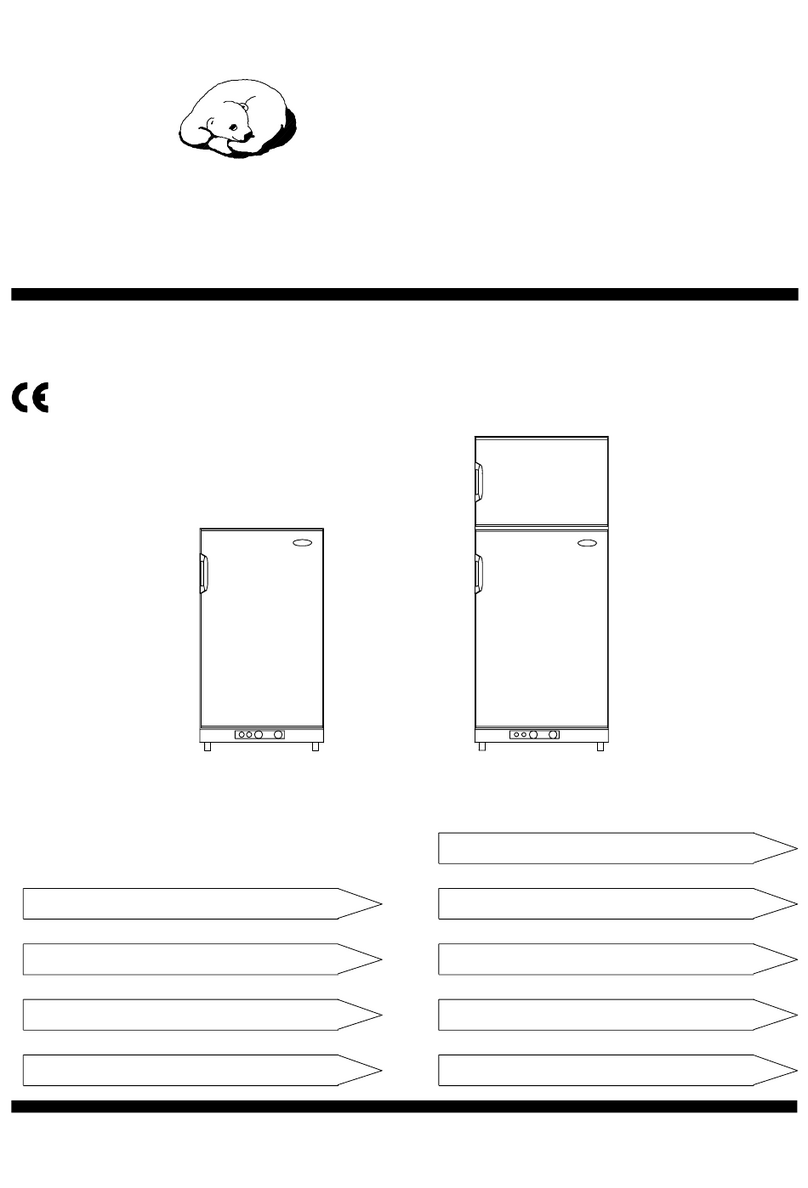Sibir V110 KE User manual

822 70 66-02
RKE - 1D
SIBIR
V110 KE
MANUAL
English page 5

2

1
A. Flue tube E. Adapter I. Thermostat
B. Flue baffle F. Burner base J. Lever arm
C. Control knob G. Lamp glass
D. Fuel gauge H. Lamp glass insert
3

23
4
7
8
5
6
abcd
A
B
C
9
4

INSTRUCTIONS FOR USE
Installation
The cabinet must be installed on a firm floor and must
be in a horizontal position. Check the water level in the
refrigerator compartment.
Avoid locating the refrigerator in a room subject to high
temperatures or strong draughts.
See that a space of at least 16 inches (400 mm) is left
free above the top of the cabinet and1 1/4 inch (30 mm)
at the rear, as well as 1 inch (25 mm) of free space on
each side of the cabinet, to allow an unrestricted circu-
lation of air, which is essential for the efficient operation
of the refrigerator. The ventilation opening at the top of
the cabinet must not be covered in any way.
The refrigerator should not be placed in a small pantry
or similar location.
The flue baffle (B) must be positioned as shown on the
illustration fig.1.
Filling the Tank
Always use the kerosene funnel when filling the tank,
and fill until the gauge pointer (D) fig.1, approaches the
red mark.
Cleanoffanykeroseneonthetopofthetank.Ifkerosene
overflows,the tankshould beremovedfromtherefriger-
ator and wiped clean.
Do not let the tank rundry whilethe refrigeratoris in use
becauserefrigerationwillbe interruptedanda portion of
the wick will be burned off, reducing the life of the wick.
Always use best quality burning kerosene (Paraf-
fin) and see that it is kept clean, dry and unadulter-
ated. Under no circumstances must vaporizing
kerosene, petrol or spirit of any kind be used.
Lighting the Burner
Rememberthatthe keroseneburner isan essential part
of the refrigerator and that care taken to maintain it in
good condition is well repaid.
Beforelightinganewwickforthefirsttime,allowthewick
to become soaked with kerosene for at least two hours.
Important
Light the wick and place the lamp glass (G) with insert
(H) in position, asshown in fig.2.Beforesliding the tank
back into place, turn down the flame by means of knob
(C) fig.1.
Push the tank into the tank holder underneath the cabi-
net and at the rear of the refrigerator. Slide the tank
carefully forwards against the guide pin.Carefully lift the
tank by means of the lever arm (J) and check that the
guide pin enter the hole in the bracket on the left side of
the burner. (FIG. 3).
Makesurethattheinsert (H)onthetopofthelampglass
seals against the bottom of the flue tube (A), it should
not be anyair gap between the flue tubeand the insert.
Lock the lever arm in the position were the insert seals
against the flue tube.
Turn the flame down halfway, see fig 8 c. The flame
generally tendsto growlarger a little while after the wick
has been lit, and it should be adjusted during the first
few hours so that it does not begin to smoke.
Regulating the temperature
Cabinet temperature is dependent on the size of the
flame. Lowest temperature is obtained with the largest
flame. The size and appearance of the flame can be
checked through the blue glass on the lamp glass.
Regulate the flame as required by means of the knob
(C).To maintainsteady cabinettemperatures, the refrig-
erator should operate continuously day and night.
Fig.8 shows what the flame may look like.In fig.8 a the
flame is too low and may easily go out. It gives little or
no refrigeration. Under normal conditions the flame
shouldbeasshowninfig.8c.Itcan,ofcourse,beturned
up to "full" as shown in fig.8 d, if required. If the wick is
turned up too much, it will begin to smoke and smell.
Day/night regulator
In low ambient temperature (e.g. night in some areas)
the refrigerator may be too cold.By moving the lever (at
the top of the refrigerator) to position "moon" the flue
baffle will be lifted up about 150 mm which reduces the
efficiency of the cooling unit.
During day time when it is hot, the lever is to be moved
to position "sun". The flue baffle will return to normal
position and the refrigerator will operate normally.
Care and maintenance
To ensure that the burner works at maximum efficiency
at all times, it will be necessary to check and adjust it
from time to time, preferably when fillingit withkerosene
each week.Clean the topof the wick to keepit even;the
flame willotherwise tend to smoke.If necessary, burner
base (F), fig. 6, may be unscrewed from the burner and
cleanedsothat itsholesdo notgetcloggedup.Keep the
tank free from dust and spilled kerosene (fire hazard).
A few times each year, or whenever necessary, soot
should be removed from the boiler tube.
Lift out the flue baffle (B), fig.1, remove the tank, place
a sheet of paper underneath the flue tube to catch the
soot.
Clean the flue tube with the brush supplied with the
refrigerator.The flue baffle should also be cleaned.
After cleaning,ensure that the flue baffle is refitted in
position.
NOTE: The refrigerator will not operate properly if
the flue baffle is not in place.
When cleaning the burner, take out the burner from the
tank and inspect the tails of the wick. If they are dirty,
unsuitable kerosene has been used and the tank must
be cleaned. Empty the tank and put the dirty kerosene
aside for other uses. Rinse the tank twice with clean
kerosene and refill with filtered kerosene.
Changing the Wick
If it is not possible to obtain a proper flame in spite of
cleaning and adjusting the wick, it is best to change the
wick.Todothis,removetheburnerandunscrewthewick.
Insert thenew wick, redend first, throughthe holeat the
bottomof the burner, fig.4.Using afinger, push the wick
in until it passes between the spring and the cog wheel.
5

The cog wheel grips the wick and it can then be turned
up above the lower edge of the burner.
Turn the wick up and down in the burner a few times to
make sure that it does not jam and can easily be regu-
lated by means of the screw.Make sure that the wick is
at the same height above the burner all the way round.
If necessary, adjust it by pulling at the top as shown in
fig. 5. The wick should project 3/8 inch (10 mm) above
the top edge of the burner. Then dip the projecting part
ofthewickinthekerosene,fig.6, andturnthewickdown
until it is barely 1/8 inch (2-3 mm) above the top of the
burner. Light it, fig.7, and let the flame burn until it goes
out by itself.When it has burned out, blow the ash away,
and the wick should now be even all the way round.
Defrosting
Remove all vaccine from the refrigerator, extinguish the
flame and leave the door and frozen storage compart-
ment door open.Thefrost will melt rapidly and run down
into a receptacle at the rear of the refrigerator where it
evaporates. Defrost water in the freezer compartment
should be mopped up with a cloth.
Itisadvisabletocleantherefrigeratorinconjunctionwith
defrosting. Use lukewarm water and a non-perfumed
detergent. Never use scouring powder, steel wool and
the like.
Before starting the refrigerator again, dry out the frozen
storage compartment and refrigeration space.
Turning off
If the refrigerator is to remain out of use, extinguish the
burner flame. Empty the cabinet, defrost it and clean it
thoroughly. Leave the door ajar.
Electric operation
Check that the voltage stated on the data plate is the
same as the mains voltage in use.
Plugtherefrigeratorpowercordintoaneasilyaccessible
earthed wall socket.
If no earthed wall socket is available consult an electri-
cian before using the refrigerator.
Refrigerator temperature is kept at a constant level by
meansof the thermostat(I) fig.1.Selectthe temperature
required by turning the thermostat knob to a suitable
figure.
This knob is graduated from 0 (marked by a spot) to
figure 7 and MAX.At the MAX positionthe cabinetis set
for continual operation, i.e.the thermostat is by-passed.
Refrigeratortemperature is controlledby the thermostat
only whenon electricoperation.When running on kero-
sene,thetemperatureiscontrolledbymeansoftheknob
(C), fig.1, on the kerosene tank.
To render the refrigerator completely electrically inert,
pull the plug out of the wall socket.
Changing from kerosene operation to
electric operation or vice versa
1. Extinguish the kerosene flame.
2. Plug the power cord into the wall socket.
3. Set the thermostat.
Switching from electric to kerosene operation:
1. Pull the power cord out of the wall socket.
2. Start the refrigerator on kerosene.
NOTE: Do not run the refrigerator on electricity and
kerosene simultaneously. Refrigerating efficiency will
therebybesomewhatimpairedbutabovealltheunitmay
overheat and ruin the refrigerating system.
Changing the heating element
The heater which is fitted inside the boiler casing (B)
fig.9, of the refrigeratorunit, can be changed as follows:
1. Pull the power cord out of the wall socket.
2. Remove the cover C.
3. Remove some insulation wool so thatthe heaterAis
accessible.
4. Open the terminal block cover and disconnect the
heater leads.
5. Turn and lift the heater out of its pocket.
6. Fit the new heater into the pocket.
7. Connecttheleadsandclosetheterminalblockcover.
8. Carefully put the insulation wool back into position
and close the cover of the boiler casing.
Fault Tracing
Refrigerator not cold enough
1. Flame incorrectly adjusted.
2. Wick uneven or too short - clean or replace it.
3. Burner needs cleaning.
4. Poor-quality kerosene.
5. Soot must be removed from the flue tube.
6. Poorsealbetweenfluetube(A) andlampglassinsert
(H) fig. 1.
7. Flue baffle (B) missing or incorrectly located.
8. Cabinet needs defrosting.
9. Door does not make good seal against the cabinet.
10. Air circulation restricted round the cooling unit. See
"Installation". The cooling unit at the rear of the
refrigerator must be cleaned.
11. The cabinet is not level.
Refrigerator too cold:
The wick is turned up too high.
Refrigerator not cold:
1. Burner has gone out.
2. Kerosene tank empty.
3. Wick or burner must be cleaned.
Smell of kerosene:
1. Wick turned down too far.
2. Wick or burner must be cleaned.
3. Poor-quality kerosene.
6

Points to remember
•Keep the refrigerator level.
•Defrost weekly or fortnightly.
•Keep the burner clean.
•Do not overload the refrigerator so thatthe air cannot
circulate freely inside the cabinet.
•Use only good grade of kerosene-paraffin.
•Do not let the fuel tank run dry.
•Inspect the flame regularly.
7

MO-FO 0139
Sibir International AB
S-105 45 Stockholm
Sweden
Phone + 46-8-738 61 18
Fax + 46-8-738 75 38
Table of contents
Other Sibir Refrigerator manuals
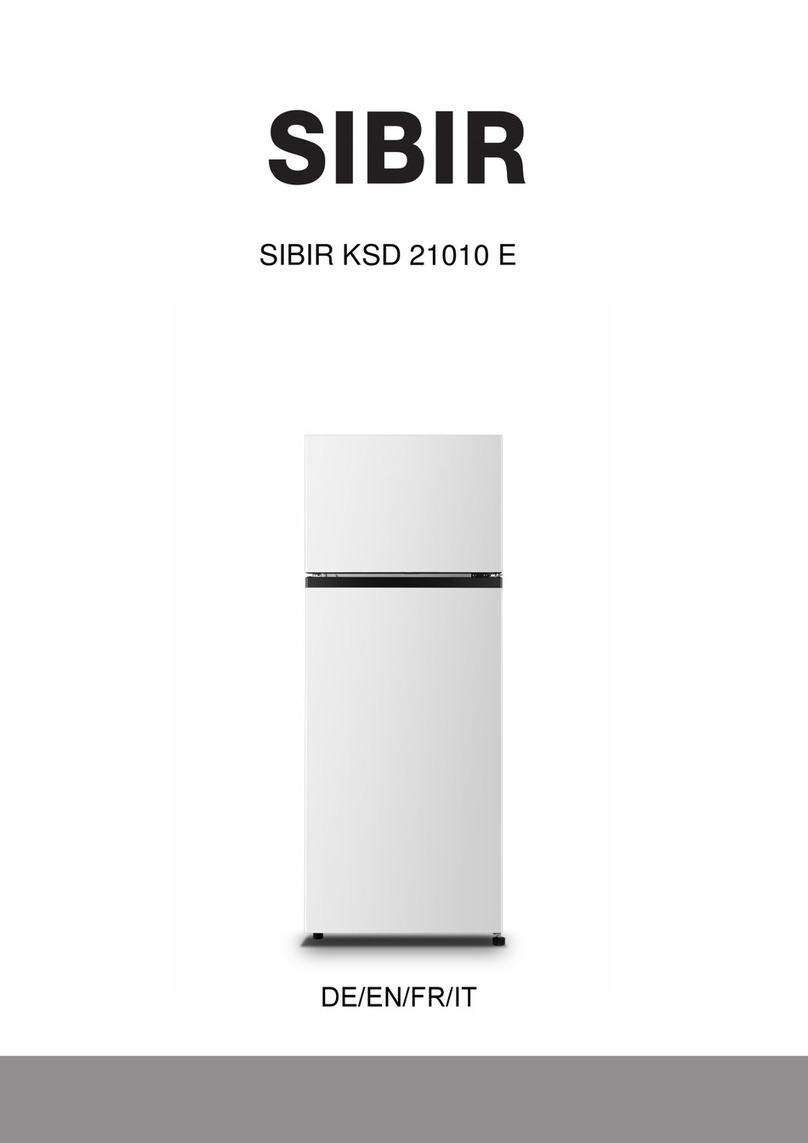
Sibir
Sibir KSD 21010 E User manual

Sibir
Sibir V 110 GE User manual

Sibir
Sibir KOMFORT User manual
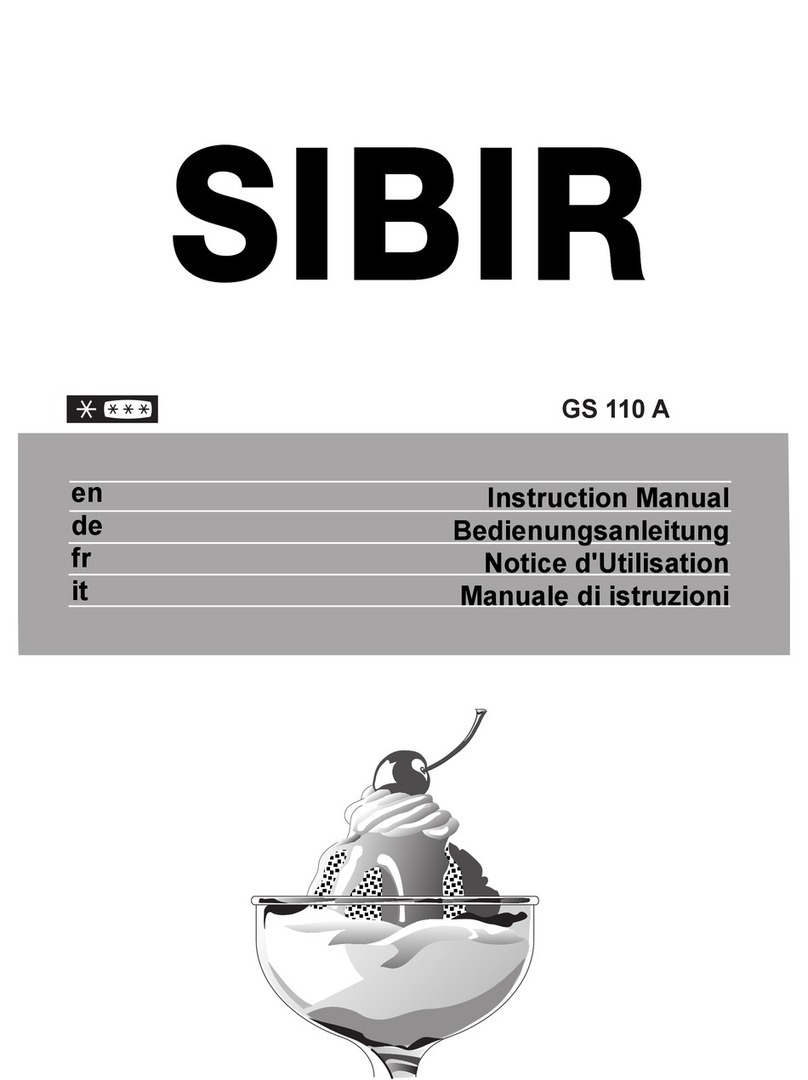
Sibir
Sibir GS 110 A User manual

Sibir
Sibir 803K User manual
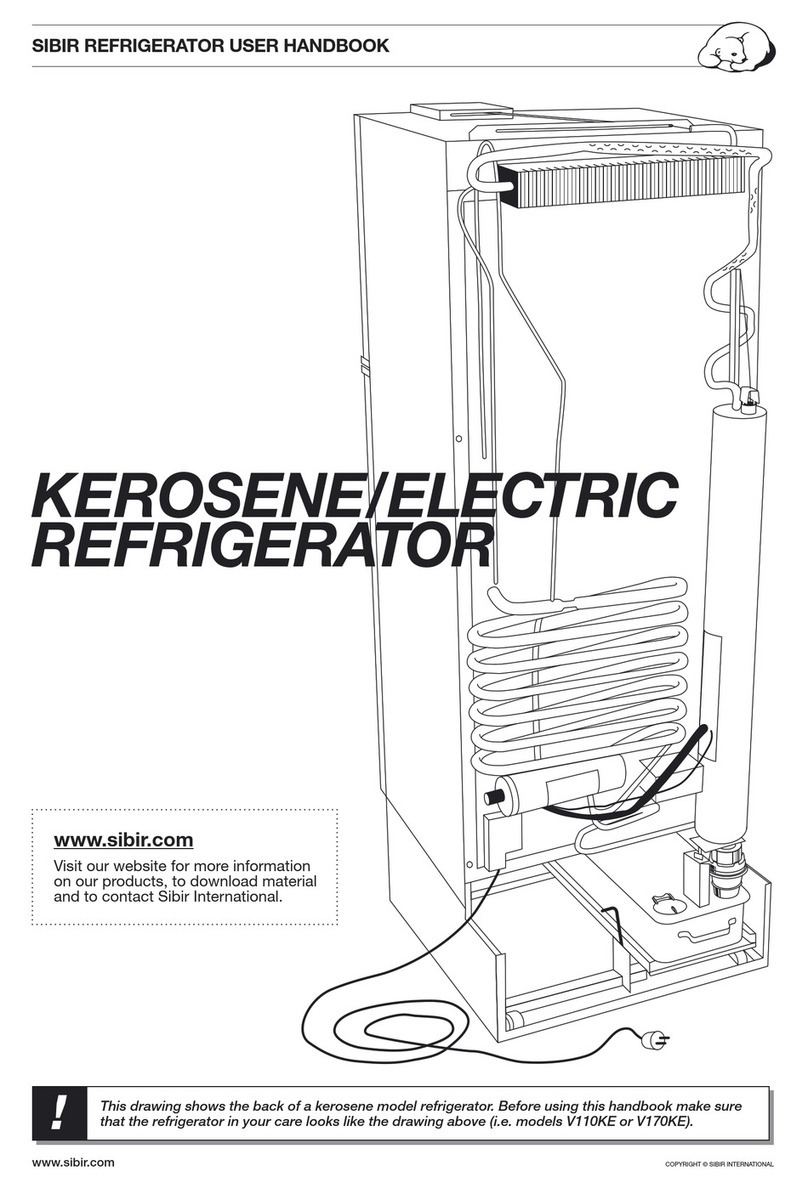
Sibir
Sibir V110KE Instruction Manual

Sibir
Sibir 803K User manual

Sibir
Sibir RC1200 EGP User manual
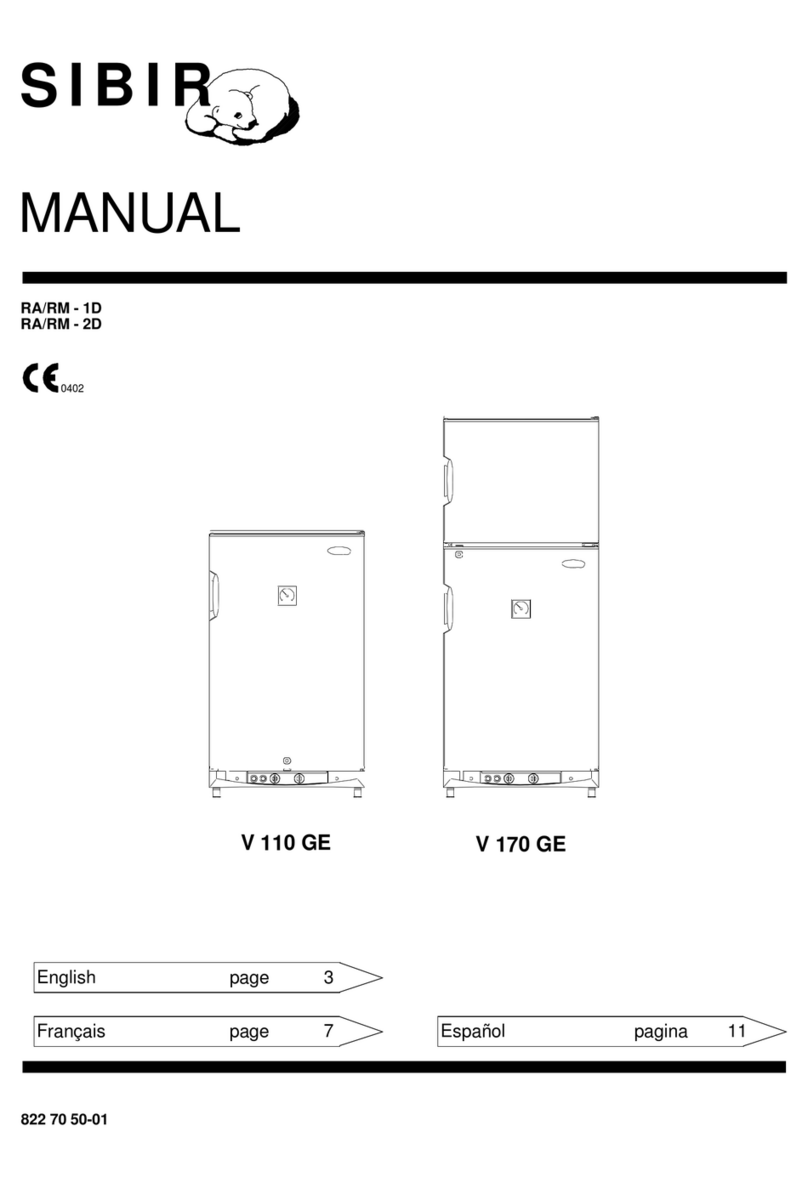
Sibir
Sibir RA 1-D User manual
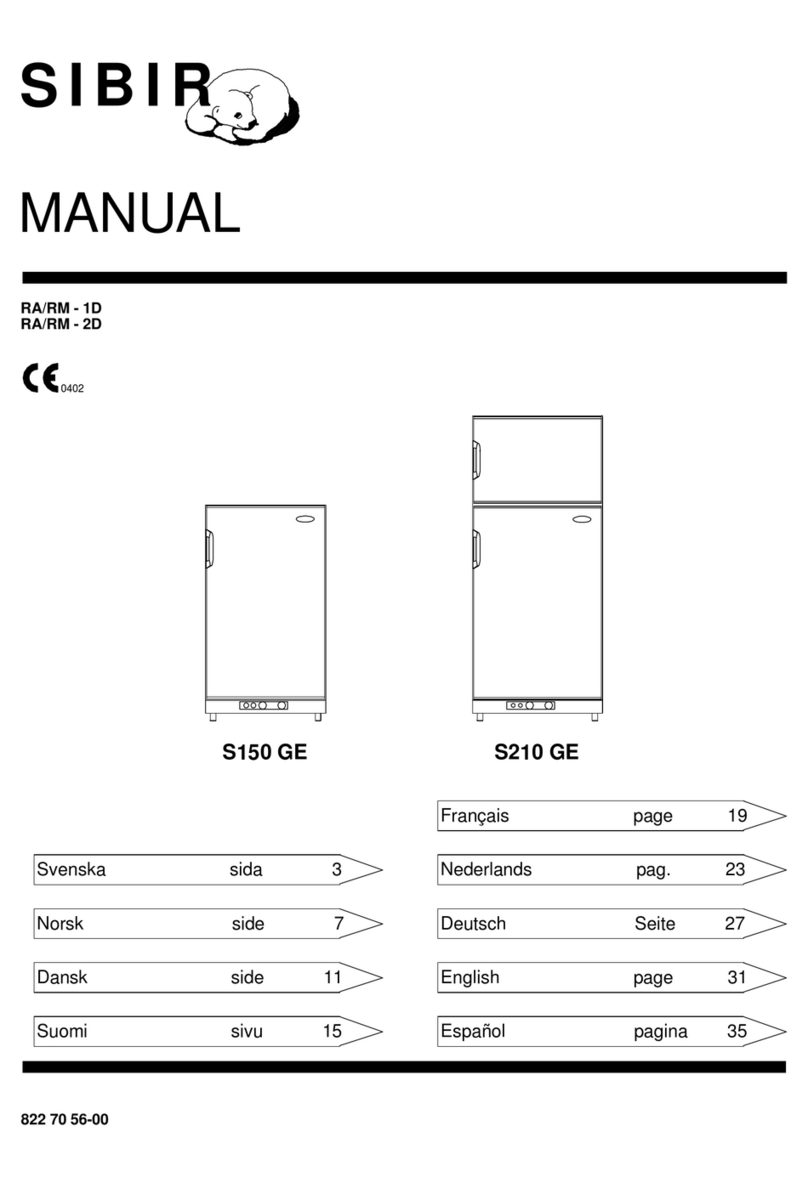
Sibir
Sibir S150 GE User manual


